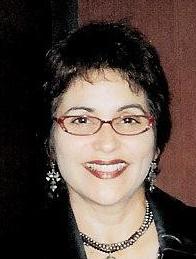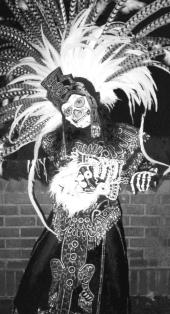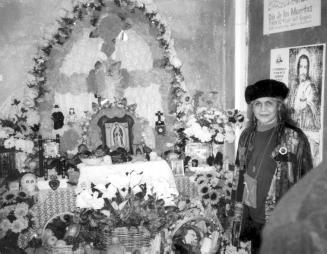| Teaching Chicanos/as and Religion: Traditions and Transformations |
![PDF-NOTE: Internet Explorer Users, right click the PDF Icon and choose [save target as] if you are experiencing problems with clicking.](http://rsnonline.org/templates/rsntemplate-smallmasthead/images/pdf_button.png) |
 |
Lara Medina, California State University, Northridge
I have taught a course on Chicana and Chicano religiosity since 1992, first at the University of California, Los Angeles, and now at California State University, Northridge. The students are primarily of Mexican ancestry, although more with roots in Central America are now attending, as the demographics in Los Angeles change. The course also attracts a few non-Latinos preparing for teaching professions in public elementary schools. Many are searching for more knowledge about themselves and notions of God. Many express interest in learning about their Indigenous roots, knowledge denied them in the Western educational system. Most have never studied religion from a nontheological perspective, nor challenged Christian doctrine. I provide the opportunity to question religious “truths” constructed within historical and gendered contexts, so they may think critically about their own traditions and cultures. It is through the process of critical thinking about religion that one kind of healing can occur. My emphasis on Indigenous epistemology challenges the majority to confront their internalized biases toward non-Christian and non-Western worldviews. For Chicanos/as who are products of biological and cultural mestizaje (cultural and biological hybridity), reconciling the differences and discovering the similarities between Christian and Indigenous traditions offer healing. Healing in this context is about bringing forth self-knowledge and historical consciousness allowing one to claim religious agency, or the ability to determine for oneself what is morally and ethically just, and what enables communication with spiritual sources. For young women in the class, discussions about moral authority over one’s body constitute a central part of the healing process. The personal nature of the students’ interest in religion influences the course design as I attempt to address their searches, as well as provide an understanding of how religion shapes Chicano/a culture. I start with religious diversity within Chicano/Latino communities. While the majority remains Catholic, I address their historical presence within Protestant denominations, and growing numbers in Islam, Bahá’í and Santería. I also insert discussions of gender within patriarchal religions, leading to discussions about transformations that women are making in religious discourse and practices. Beginning the course around multiple religious identities, which includes my own story, helps create an atmosphere that encourages diversity, dialogue, and critical thinking. I next provide a basic understanding of Mexican Indigenous epistemology as a framework for understanding contemporary Mexican and Chicano/a religiosity. A central theoretical premise of the course is that mestizaje shapes the foundation of such religiosity. One cannot understand this mestizaje without some understanding of Mesoamerican Indigenous epistemology. I emphasize the concepts of duality, fluidity, balance, metaphorical language, corporeal/spiritual animistic sites, circular time, interdependency, reciprocity, sacrifice, flor y canto (flower and song), and cara y corazón (face and heart), sketching the fundamentals of this worldview. Grounding the course in these concepts is important, because when we look at the merging of Indigenous spirituality and Spanish Catholicism, and later Chicano religiosity, we can name the Indigenous values that continue to be active today. Students can then identify how Indigenous epistemology and practice exist in much of their familial religiosity, such as the construction of altars or domestic sacred centers, or the making of promises or mandas to divine beings as an act of reciprocity between humanity and divinity. What might have seemed “superstitious or old-fashioned” can now be understood as reciprocal actions to maintain familial spiritual and cosmic balance. The experience of mestizaje provides the foundation to understand the process of conquest, colonization, and adaptation that occurred in Chicano/a religiosity. I introduce the concept of nepantla spirituality — a spirituality at the biological and cultural crossroads where diverse elements converge, sometimes in tension and sometimes in cohesion. Nepantla is a Nahuatl term, meaning “in the middle.” Nepantla spirituality is not syncretism, but an example of transculturation, or a continuous encounter of two or more divergent worldviews. Much of Mexicano/Chicano religiosity reflects nepantla spirituality, a creative blending of symbols, rituals, and meanings that allows the Indigenous, European, African, and Asian to speak and coexist.
With so much focus on the Virgin, the next step is to deal with religion and sexuality. We explore the processes that demonized female sexuality. A discussion of contemporary sexuality and spirituality develops, drawing connections between the high rate of Latina teenage pregnancy and the silencing of female sexuality in Latino cultures. We also discuss the denigration of homosexuality in traditional Chicano/Latino cultures and how Christian paradigms supplanted native understandings of the fluid nature of sexuality. We spend a significant amount of time on understanding the Mexican Indigenous/Chicano tradition of honoring and communing with the dead. As in many Indigenous cultures around the world, the dead or the ancestors play a key part in cultural continuity. The ancestors guide the living and offer protection. Constructing sacred space in their honor, leaving them gifts of food and drink, spending time with their spirits, and sharing in oral tradition ensures family stability and, most importantly, reminds the living of their historical lineage. For marginalized peoples in the United States, the simple act of remembering family history holds spiritual and political significance. Whether celebrating the dead takes place in public processions and gatherings in cultural centers, or in the privacy of a family altar, the tradition rejects mainstream attempts to ignore the histories and traditions of nonwhite and mixed-raced peoples. Through public ritual, marginalized “others” claim public space and reject efforts to dismiss their presence in an increasingly segregated society. The tradition challenges a society that privileges youth and silences the dead, underscoring the distinctiveness of non-Western epistemologies.
A section on Chicano/a Catholic Church history maps out the role of the church in the Southwest, following the Treaty of Guadalupe Hidalgo in 1848, when one million Mexican Catholics found themselves under the authority of the U.S. Catholic Church. European-born clergy ministered to the now-Mexican Americans, and a legacy of discrimination ensued. We trace this legacy through subsequent periods up to the 1970s when Chicano/a Catholics, priests, sisters, and laity openly challenged the church for its overt racist actions. Liberation theology receives attention as a catalyst for change in both Catholic and mainline Protestant denominations. A brief overview of the revolutionary struggles grounding the theology assists in explaining its extensive influence on the global church, and its positions on healing social inequities. To explore the role of Protestantism in Chicano history, I utilize the works of Gaston Espinoza, Daisy Machado, Paul Barton, David Maldonado, and Arlene Sánchez Walsh. I also introduce feminist theology, as Latina theologians are making significant contributions to the rethinking of Christianity from a perspective of racialized women. I expose students to Chicanas who are retrieving cultural archetypes for the empowerment of women and the reconstruction of culture. One primary archetype in Chicano culture is the curandera, the wise healer — usually an elder — who knows the medicinal properties of plants, corporeal energy sites, and/or ways to mediate with the dead. Many students have internalized Western ignorance regarding curanderismo and have been socialized to think of it as “witchcraft.” Yet curanderismo underscores the value of indigenous knowledge and the use of intuitive and cognitive skills to challenge Western patriarchal norms. How this course evolves each semester varies, depending on the mix of students and what issues might deserve more time and attention. Overall, I try to have fun with the subject matter. Mexican/Chicano religiosity is full of magic and mystery and rich in material culture. Faith has sustained the majority of my students’ families, but religion has been passed on without room for questioning. I emphasize that questioning one’s beliefs leads to self-knowledge and self-knowledge leads to healing. Selected ResourcesCarrasco, David. Religions of Mesoamerica: Cosmovision and Ceremonial Centers. Prospect Heights, IL: Waveland Press, 1998. Dolan, Jay P., and Gilberto M. Hinojosa, eds. Mexican Americans and the Catholic Church, 1900–1965. Notre Dame, IN: University of Notre Dame Press, 1994. León, Luis. La Llorona’s Children: Religion, Life, and Death in the U.S.-Mexico Borderlands. Berkeley: University of California Press, 2003. Matovina, Timothy, and Gary Riebe-Estrella, eds. Horizons of the Sacred: Mexican Catholic Traditions in the U.S. Ithaca, NY: Cornell University Press, 2002. Medina, Lara. Las Hermanas: Chicana/Latina Religious-Political Activism. Philadelphia: Temple University Press, in press. Sánchez Walsh, Arlene. Latino Pentecostal Identity: Evangelical Faith, Self, and Society. New York: Columbia University Press, 2003. |


 Lara Medina is an Assistant Professor in the Department of Chicano and Chicana Studies at California State University, Northridge. Her published work focuses on Chicana/o spirituality and practices, U.S. Latino/a theology, and Chicano/a religious history, and includes Las Hermanas: Chicana/Latina Religious-Political Activism (Temple University Press, forthcoming).
Lara Medina is an Assistant Professor in the Department of Chicano and Chicana Studies at California State University, Northridge. Her published work focuses on Chicana/o spirituality and practices, U.S. Latino/a theology, and Chicano/a religious history, and includes Las Hermanas: Chicana/Latina Religious-Political Activism (Temple University Press, forthcoming). A critical historical perspective on Our Lady of Guadalupe follows, as a fundamental expression of nepantla spirituality. Her image embodies the coexistence of the Spanish Catholic and the Mesoamerican Indigeous symbol system. I balance a scholarly treatment of Guadalupe with the significance of oral tradition in the “Guadalupe event.” Faith and the testimonies of Guadalupanas (devotees of Guadalupe) receive equal treatment with the lack of historical evidence for the event. I provide a timeline beginning in 1521 when the apparition is dated, and ending in 2003 with the canonization of St. Juan Diego by the papacy, to illustrate the power that her mythology has on a culture and a global church. Students are required “to read Guadalupe’s image” as a Nahuatl codice, one that speaks with metaphors through its colors and symbols. Gender must also be addressed, as Guadalupe has historically been used as a symbol of liberation in revolutionary struggles. Yet for women, she continues to be used as an archetype of the “good woman” — an all-sacrificing mother — negating her sexuality. Revisionist art by Chicana artists shows the feminist transformations that Guadalupe is undergoing.
A critical historical perspective on Our Lady of Guadalupe follows, as a fundamental expression of nepantla spirituality. Her image embodies the coexistence of the Spanish Catholic and the Mesoamerican Indigeous symbol system. I balance a scholarly treatment of Guadalupe with the significance of oral tradition in the “Guadalupe event.” Faith and the testimonies of Guadalupanas (devotees of Guadalupe) receive equal treatment with the lack of historical evidence for the event. I provide a timeline beginning in 1521 when the apparition is dated, and ending in 2003 with the canonization of St. Juan Diego by the papacy, to illustrate the power that her mythology has on a culture and a global church. Students are required “to read Guadalupe’s image” as a Nahuatl codice, one that speaks with metaphors through its colors and symbols. Gender must also be addressed, as Guadalupe has historically been used as a symbol of liberation in revolutionary struggles. Yet for women, she continues to be used as an archetype of the “good woman” — an all-sacrificing mother — negating her sexuality. Revisionist art by Chicana artists shows the feminist transformations that Guadalupe is undergoing. At the end of the semester, students must construct ofrendas (offerings) to a deceased member of their family or community. The ofrenda can be designed in a box that is easily carried to class. They must decorate the container with symbols and photos representing the life of the deceased. In their oral presentations they offer a brief biographical sketch followed by an explanation of the symbols they chose to represent the deceased. For many students, building the ofrenda, explaining it to the class, and writing a summary facilitates a healing process by enabling them to confront the pain of loss. Many express how meaningful the assignment is not only for themselves, but also for their families. Oftentimes they will have to ask a parent to tell them more about a deceased family member, the exchange facilitating the sharing of family history previously untold.
At the end of the semester, students must construct ofrendas (offerings) to a deceased member of their family or community. The ofrenda can be designed in a box that is easily carried to class. They must decorate the container with symbols and photos representing the life of the deceased. In their oral presentations they offer a brief biographical sketch followed by an explanation of the symbols they chose to represent the deceased. For many students, building the ofrenda, explaining it to the class, and writing a summary facilitates a healing process by enabling them to confront the pain of loss. Many express how meaningful the assignment is not only for themselves, but also for their families. Oftentimes they will have to ask a parent to tell them more about a deceased family member, the exchange facilitating the sharing of family history previously untold.